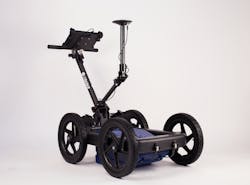GP Rover combines US Radar’s triple-bandwidth GPR technology with precision GPS (Global Positioning System) connectivity. The system, says US Radar, can create subsurface maps in real time, with no base station or control points required, and the system is accurate to within 2 inches. According to US Radar, “the GP Rover connects with the global Starfire GPS network—a service of John Deere subsidiary NAVCOM, enabling the new system to provide full GNSS (Global Navigation Satellite System) reception and to automatically receive corrections from International Maritime and Marine Satellites.” According to the company, maps created using the GP Rover provide a permanent and updateable record that can be shared by all contributors to a project, thus assisting in overcoming the limitations of impermanent “mark-outs” and potential errors in subsequent excavation.
Patented tilt-correction technology automatically compensates for slope and cross-slope of the GPR and GPS antennas to increase overall accuracy on uneven terrain. Field data collected by the GP Rover can be saved and shared in any of the five most common file formats—SHP, DXF, KMZ, CSV, RTF—used in mapping and engineering applications, such as AutoCad, Google Earth, GIS, and point files. A “field-to-finish” capability in US Radar’s software program, Radar Studio, is designed to eliminates possible confusion and error by automatically mapping coordinate points that are identified with the same name, such as “Gas Line 1.”
According to the company, triple-frequency radar provides superior imaging in a wide variety of applications, from analysis to locating and imaging utilities at depths to 30 feet. Ultra-wideband pulses are designed to combine the advantages of pulse radar and stepped-frequency radar, allowing detection of objects such as conduit and rebar, while rendering high-resolution imagery of those objects. Direct radio-frequency-sampling technology is designed to create clearer, easier-to-understand images than previously possible with older radar technologies, says the company.
The GP Rover uses the same battery for both GPR and GPS systems, and the system’s integrated electronics are packaged into the GP Rover’s waterproof and dustproof antenna for an IP65 weatherproof rating.





